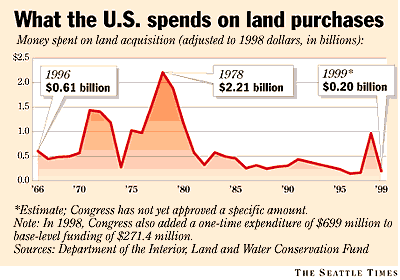Low on money, feds rely on barter system
When buffalo wander out of Yellowstone National Park, some enter a ranch owned by a sect called the Church Universal and Triumphant.
Often, they are shot.
In an effort to curb the killing, the federal government is considering buying 7,500 acres from the church for $13 million. The proposal has attracted attention, but what most don't know is that in 1981, the feds passed up a chance to buy the entire 13,000-acre ranch for $6.5 million.
Such missed opportunities are emblematic of the federal land-buying program.
Set up in 1964 by Sen. Henry Jackson of Washington, the program has been so underfinanced and ignored for the past two decades that the government has been able to buy only a fraction of what it purchased in the 1960s and '70s.
As a result, federal officials have turned to a barter system as their primary means of acquiring land.
"Land exchanges are more and more of how we do business, since Congress hasn't seen fit to give us money for purchases of sensitive land," said Jim Lyons, who oversees the Forest Service. "Unfortunately, Congress has taken away one of our tools."
Thirty years ago, Jackson argued that this tool should be expanded dramatically. The government was spending nearly twice as much on park land as it is now, adjusted for inflation. But Jackson declared it was not enough to meet the public's demand for parks.
He proposed a novel solution: Taxes levied on what he described as a "resource-depleting activity" - oil-drilling off America's shores - would be "reinvested in outdoor recreation areas and developments, which will become a part of the permanent estate of the nation."
Today, nearly $1 billion a year from oil drilling flows into what's called the Land and Water Conservation Fund, to be used to buy forest land, lakes, parks, trails and historic sites in all 50 states.
The fund has purchased nearly 7 million acres of land for preservation, including parts of the North Cascades National Park in Washington.
But if Jackson were alive today, he might wonder what happened to his program. Most of the oil money flowing into the parks fund is no longer spent on parks. In the decade of the 1990s, for instance, the fund has produced $900 million each year. Only about $200 million of that is used to buy small park projects; the rest is sent back to the general treasury, where it is used for other programs and to reduce the deficit.
Adjusted for inflation, the nation invested three times as much money on park-land purchases in the 1970s as it has in the 1990s.
"There is a strong sentiment among many Republicans in Congress that the federal government is too big and simply should not expand its land holdings, for any purpose," said Kevin Collins, a lobbyist for the National Parks and Conservation Association, which tries to bolster the national-park system.
Earlier this year, the House's chief budget writer, Rep. John Kasich, R-Ohio, proposed doing away with the program completely. His proposal has not survived, in part because record tax revenues have given the government a balanced budget much earlier than anticipated.
But the budget situation is not translating into more money for park and forest land. This year, the House has proposed spending $131 million on all land acquisitions, which would be a record low in the 35 years of the program. The Senate has proposed $240 million, still far less than the early 1980s.
Buying land for conservation, while simpler than trading, can be fraught with many of the same problems, such as rigged appraisals or political deal-making. The public may still get a bad deal.
But the price of missed deals can be even higher. In 1992, Plum Creek Timber offered 170,000 acres of land near Yellowstone for what was then a bargain price, $25 million. But there was no hope of the Forest Service getting the money, so Plum Creek sold to a company that planned to log and develop the wilderness.
The political fallout led to legislation ordering the Forest Service to acquire the land through a complex series of exchanges, timber sales and cash transactions. After five years of community hand-wringing over which public land to sacrifice, Congress is expected to approve the final phase of the deal this session.
The final tab: about $75 million in land, timber and tax dollars for 100,000 acres - five times the cost per acre of the original deal.


